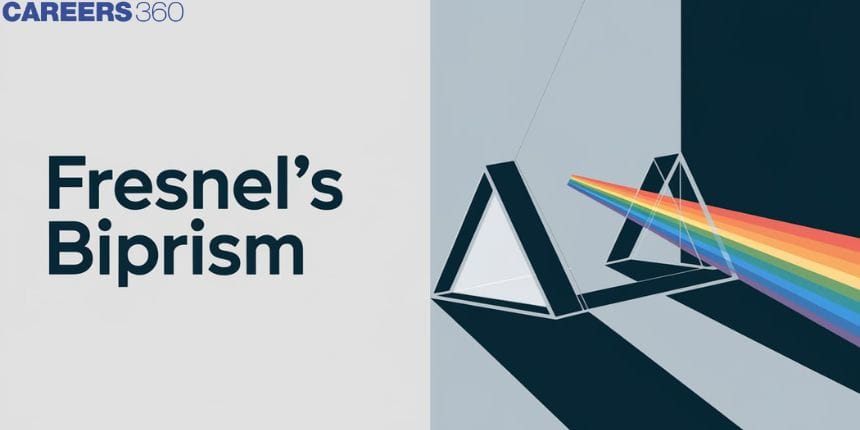Fresnel's Biprism
Fresnel's Biprism Experiment is a classic demonstration of the wave nature of light, designed by Augustin-Jean Fresnel. In this experiment, biprism, which is essentially two prisms joined at their bases, splits a single light source into two coherent beams. These beams then interfere, producing an interference pattern of bright and dark fringes. This experiment not only provides evidence for the wave theory of light but also allows precise measurement of the wavelength of light. In real life, understanding such interference principles is crucial in fields like optics and photonics, impacting technologies like optical instruments, holography, and even advanced techniques in microscopy and telecommunications. In this article, we will discuss the concept of Fresnel's Biprism and provide examples for better understanding.
This Story also Contains
- Fresnel's Biprism
- Solved Examples Based on Fresnel's Biprism
- Summary

Fresnel's Biprism
Fresnel's Biprism is an elegant optical experiment developed by Augustin-Jean Fresnel to demonstrate the wave nature of light. This experiment uses a specially designed biprism, which effectively involves two prisms joined at their bases to split a single light source into two coherent beams. These beams overlap and interfere, creating a pattern of bright and dark fringes on a screen. Fresnel's Biprism experiment not only confirms the wave theory of light but also allows precise measurement of light's wavelength. It is an optical device for producing interference of light Fresnel's biprism is made by joining base to base two thin prism of very small angle. When a monochromatic light source is kept in front of biprism two coherent virtual sources
Fringes are of equal width and their value is

Let the separation between
Recommended Topic Video
Solved Examples Based on Fresnel's Biprism
Example 1: In a Fresnel's biprism experiment, the distance between the source and eyepiece is given 100 m and two slits are kept at a separation of 1.5 m. The observed fringe width is 0.5 mm. What will be the wavelength of light?
1)
2)
3)
4)
Solution:
Fresnel's Biprism
Fringes width has value as
Given,
D= 100 m
d= 1.5 m
Using the formula of fringe width:
Therefore,
Putting the given values into the formula
Hence, the answer is the option (4).
Example 2: In a Fresnel's Biprism experiment Interference Fringes are observed with a biprism of refracting angle of 2° and refractive index of 1.5 on a screen which is 100m away from the source. If the distance between the source and the biprism is 20m and the fringe width is 0.10 mm what is the wavelength of light?
1)69.7 nm
2)6.97 mm
3)697 nm
4)None of these
Solution:
First of all, find deviation,
we know,
where a is the distance between source and biprism. e.g. a = 20m
so,
now, use the formula of fringe width,
here,
Hence, the answer is the option (3).
Example 3: If the prism angle
1)
2)
3)
4)
Solution:
Fringe width
Hence, the answer is the option (1).
Example 4: How large can be the aperture opening to work with laws of ray optics using monochromatic light of wavelength 450 nm to a distance of around 20 m?
1)6 mm
2)3 mm
3)2 mm
4)8 mm
Solution:
Now, here we are given Fresnel distance equal to
Putting
Hence, the answer is the option (2).
Example 5: How large can be aperture opening to work with laws of ray optics using a monochromatic light of wavelength 800 nm to a distance of around 20 m?
1) 6 mm
2) 4 mm
3) 2 mm
4) 8 mm
Solution:
Now, here we are given Fresnel distance equal to
Putting
Hence, the answer is the option (2).
Summary
Fresnel's Biprism experiment effectively demonstrates the wave nature of light by producing interference patterns from a single light source split into two coherent beams. The experiment involves calculating fringe width and understanding the relationships between the wavelength of light, the distances involved, and the properties of the biprism. It has practical applications in fields such as optics and photonics, influencing technologies like holography and advanced microscopy. The solved examples illustrate the use of formulas to determine fringe width and wavelength, showcasing the precision and importance of this optical phenomenon.